2013 MacBook Air: PCIe SSD and Haswell ULT Inside
by Anand Lal Shimpi on June 10, 2013 10:01 PM EST- Posted in
- Mac
- Storage
- SSDs
- Apple
- MacBook Air
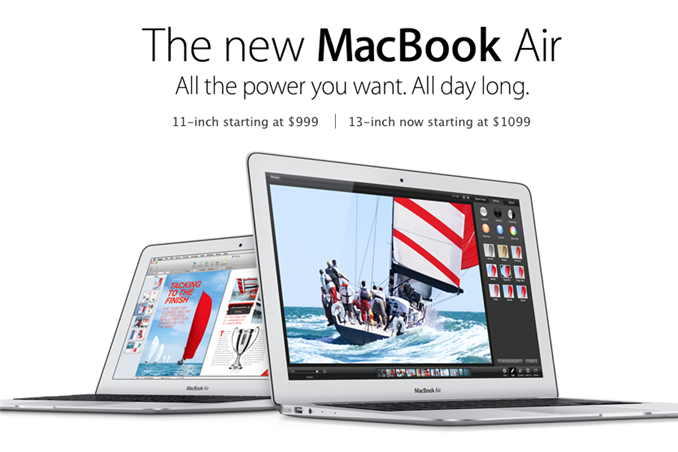
This morning Apple updated its MacBook Air to Intel's Haswell ULT silicon. The chassis itself didn't get any updates, nor did the displays. Both the 11 and 13 inch models retain their non-Retina 1366 x 768 and 1440 x 900 displays. There's a slight increase in battery capacity. The 11-inch model moves to 38Wh (8.6%) while the 13-inch model goes to 54.4Wh (8.8%). The big changes however are on the CPU, NAND and DRAM fronts.
With the new MacBook Air, Apple moves to a Core i5-4250U. The base clock drops to 1.3GHz across all of the models, but max turbo remains at 2.6GHz. Although the base clock is lower, I wouldn't expect substantially lower performance since the max turbo is unchanged as is the chassis that has to dissipate the thermals. To confirm, I ran a couple of Cinebench tests and generally found performance similar to that of last year's models:
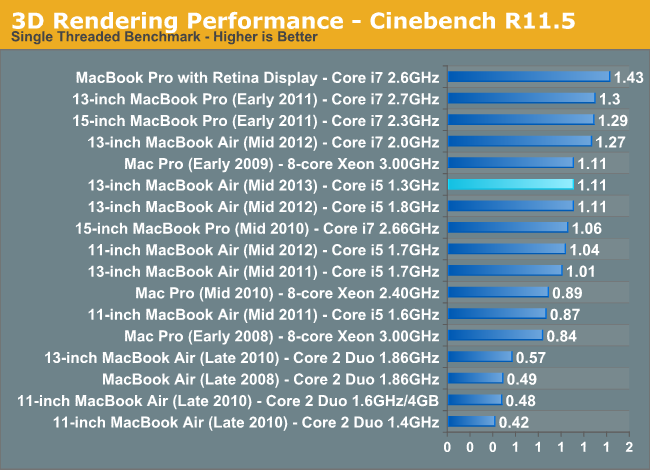
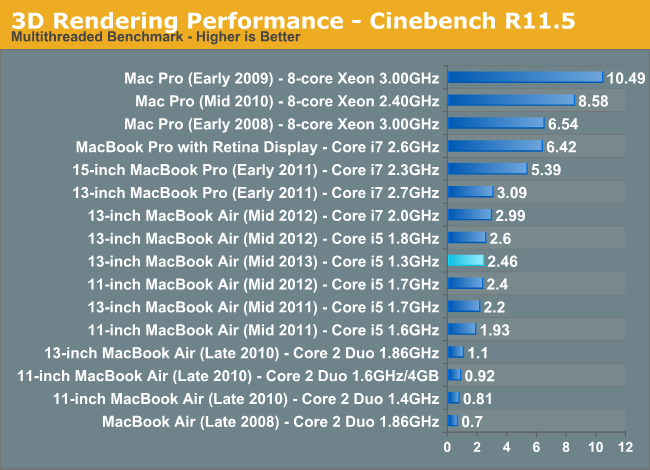
The 1.8GHz i5 in the 13-inch ended up being a bit quicker than the 1.3GHz 4250U this generation in the multithreaded test, but in single threaded performance the two are equal. The impact on the MT test is about 5%, it's there but not substantial. Don't be fooled by base clock, it's the combination of base clock, max turbo and cooling solution that'll determine performance here. As we found in our Haswell ULT review, CPU performance isn't something you can expect to see more of with Haswell vs. Ivy Bridge in these low wattage platforms.
You can get a 1.7GHz Core i7 upgrade with a 3.3GHz max turbo (i7-4650U). Both parts have Intel GT3 graphics clocked at a max of 1GHz on the i5 and 1.1GHz on the i7. Since the max GPU clocks are south of 1.2GHz, this is officially Intel's HD 5000 graphics and not Iris despite using the same silicon. The GPU base clock drops from 350MHz down to 200MHz, which should help reduce idle power consumption.
| 2013 MacBook Air Lineup | ||||||
| 11.6-inch | 11.6-inch (high-end) | 13.3-inch | 13.3-inch (high-end) | |||
| Dimensions |
H: 0.11-0.68" (0.3-1.7cm) W: 11.8" (30cm) D: 7.56" (19.2cm) |
H: 0.11-0.68" (0.3-1.7cm) W: 12.8" (32.5cm) D: 8.94" (22.7cm) |
||||
| Weight | 2.38 lbs (1.08kg) | 2.96 lbs (1.35kg) | ||||
| CPU | 1.3GHz dual-core Core i5 | 1.3GHz dual-core Core i5 | ||||
| GPU | Intel HD 5000 | |||||
| RAM | 4GB LPDDR3-1600 | |||||
| SSD | 128GB PCIe SSD | 256GB PCIe SSD | 128GB PCIe SSD | 256GB PCIe SSD | ||
| Display Resolution | 1366 x 768 | 1440 x 900 | ||||
| Ports | Thunderbolt, 2x USB 3.0, headphone jack | Thunderbolt, 2x USB 3.0, SD card slot, headphone jack | ||||
| Price | $999 | $1199 | $1099 |
$1299 |
||
On the storage front, Apple officially leads the charge with the move to PCIe based SSDs. The upcoming Mac Pro, as well as the new MacBook Airs both use PCIe based SSDs instead of SATA drives. A quick look at OS X's system profiler reveals a PCIe 2.0 x2 interface, capable of 1GB/s in each direction.
The drive in my system uses a Samsung controller, although I've heard that SanDisk will have a PCIe solution for Apple as well. A quick run through Quick Bench reveals peak sequential read/write performance of nearly 800MB/s:
This is a pretty big deal, as it is probably the first step towards PCIe storage in a mainstream consumer device that we've seen. I'm still awaiting official confirmation as to whether or not this is an M.2 based solution or a proprietary connector. Update: It's a custom Apple design, not M.2. Since there's no PCIe routed off of the CPU in Haswell ULT, these 2 lanes come from the on-package PCH.
The other big change is the move from DDR3L to LPDDR3, a new feature supported by Haswell ULT. I need to go back and dig through the Haswell ULT datasheets again, but I believe the total memory interface width remains at 128-bits wide even if you use LPDDR3 - you just get lower power consumption.
Obviously battery life is the biggest improvement here with the new MacBook Air. Thanks to Haswell's platform power optimizations, Apple claims up to 12 hours on a single charge for the 2013 13-inch MacBook Air. Given the improvements I saw in our Haswell ULT review, I don't doubt that we could see some very good numbers out of these notebooks.
I just got my hands on a 13-inch 2013 MBA and I'll be running performance tests (including the first look at Intel's HD 5000 graphics) over the coming days. I'm still traveling until Thursday but I'll do my best to run battery life tests while I'm on the road as well. More soon!


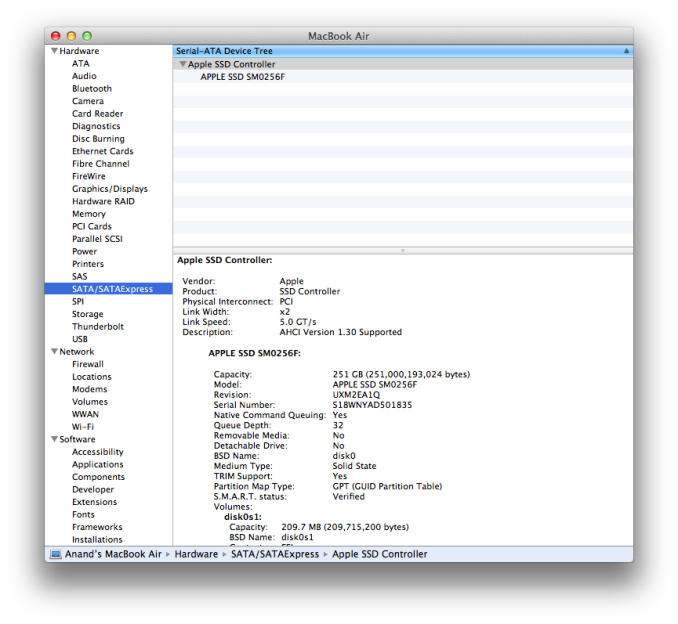

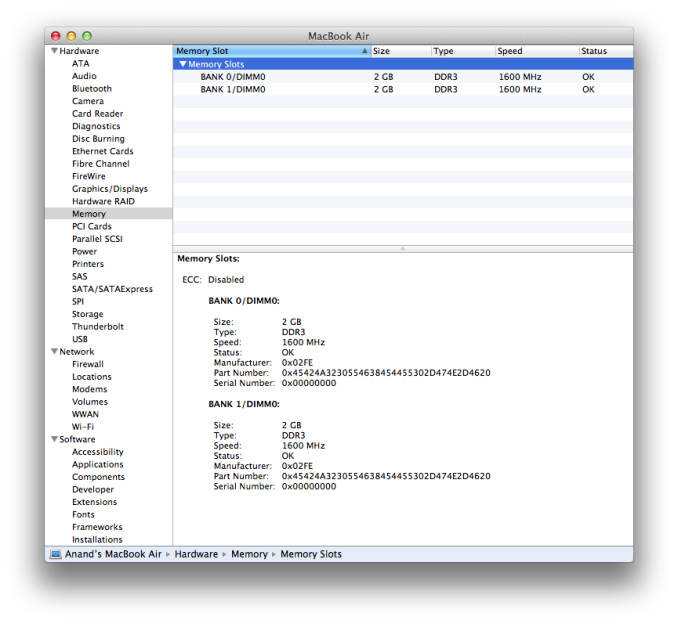








174 Comments
View All Comments
SamuraiSausage - Wednesday, June 12, 2013 - link
This would be interesting to me as well. Working in a heavy Windows environment, running some apps in Fusion +Unity is a daily occurrence. Would like to see if 6+ hours on battery is possible.wiz329 - Tuesday, June 11, 2013 - link
I'm curious @Anand, what are the benefits of 800 MB/s over 500 MB/s sequential transfers, unless you are routinely copying large files from an external TB SSD?dstroot - Tuesday, June 11, 2013 - link
Help! Definitely getting a 13 inch air / 256gb HD. Questions are:- Worth it to upgrade RAM to 8gb?
- Worth it to upgrade to 1.7Ghz CPU?
Use case is my main laptop - some web development and light iOS development and lots of email/web surfing. Travel a bit so I like the battery life.
Agree with the comments that a 1080p screen would be nice but when at home I think I will use an external display anyway...
So advice? Thanks!
r3b3lspy - Wednesday, June 12, 2013 - link
Same question here, debating between i5 or i7 processor, all tests at Apple were done using the i5 and I'm afraid the i7 will get a hit on battery life, it will run hotter and the fan will start sooner than the i7 (this happened on the 2012)mavere - Wednesday, June 12, 2013 - link
As a long time user of a 4GB RAM Macbook... get 8GB or don't buy it at all.Neurus - Wednesday, June 12, 2013 - link
I'm a long time Mac user. I have had a 11 MBA since 2011 (mid). If you can, max our ram and CPU. Yes. It's more money, but the machine will last 2-3 years minimum (depending what you do) and The more you have, the snappier will feel in the future. Even if it's "only a mere increase in performance" in the future, new versions of OSX, new things, will require more power. I've been using my MBA for iOS and Android development, so I'm the 5% of users who don't use a MBA for "occasional email/web/netflix". i really push this tiny 11. I have the i7/4g/256 (all you could get back then).I will be getting a new one only for the USB3. The difference is noticeable (vs. USB2) and I need external storage for different reasons.
karamazovmm - Tuesday, June 11, 2013 - link
"Update: It's a custom Apple design, not M.2. Since there's no PCIe routed off of the CPU in Haswell ULT, these 2 lanes come from the on-package PCH."Im sorry could you explain this to me? whats wrong in using the lanes from the pch? those are after all the pcie 2.0 x2 lanes required in the specs arent they?
http://www.sata-io.org/documents/NVMe%20and%20AHCI...
and if we look at the hardware overview, I dont see a clear reason why it needs to be proprietary because it uses the pch pcie.
Can you please explain?
ssiu - Tuesday, June 11, 2013 - link
Apple could have used i5-4350U instead of i5-4250U to minimize the "new CPU is slower (or not faster) than old one" complaints. But I am glad Apple uses i5-4250U instead of (i5-4200U with higher base CPU clock but cut-in-half HD4400 GPU).And I didn't expect retina this year but was hoping for IPS screen. This is still a premium $1k+ notebook (even if it is low-end for Apple), and even the lowly iPod Touch has IPS screen.
The battery life and SSD improvements are very good.
Mr Perfect - Tuesday, June 11, 2013 - link
In the screen shot showing SATA/SATAExpress properties, there is a line that states "TRIM Support: Yes". Last I knew, OSX did not support trim, has this changed?ThreeDee912 - Tuesday, June 11, 2013 - link
TRIM has been in OS X since 10.6.8, but it's only turned on by default for macs that come with an SSD. If you add your own third-party SSD, you have to edit some plist files to enable it manually.